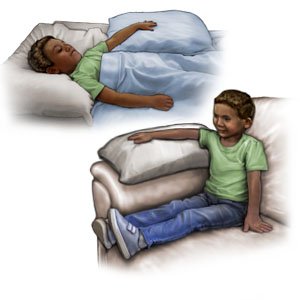Closed Reduction Internal Fixation of Upper Extremity Fracture in Children
Medically reviewed by Drugs.com. Last updated on Sep 23, 2025.
Closed reduction internal fixation has been done to put your child's broken bone back into position. The bone may be held in position by pins, wires, flexible screws, or metal plates. Your child may also have a splint or a cast. It is normal for your child to have pain and swelling after surgery.
DISCHARGE INSTRUCTIONS:
Call 911 for any of the following:
- Your child feels lightheaded, short of breath, or has chest pain.
- Your child coughs up blood.
Seek care immediately if:
- Your child has severe pain, even after taking medicine.
- Your child's cast or splint breaks.
- Your child cannot move his or her arm or fingers.
- Your child has tingling or numbness in his or her arm or fingers.
Contact your child's healthcare provider if:
- Your child has a fever or chills.
- Your child's cast or splint gets wet or begins to smell.
- Your child's bandage or cast feels too tight or too loose.
- Your child has a lot of itching under the cast or splint.
- You have questions or concerns about your child's condition or care.
Medicines:
Your child may need any of the following:
- Prescription pain medicine may be given. Ask your how to give this medicine safely to your child.
- Acetaminophen decreases pain and fever. It is available without a doctor's order. Ask how much to give your child and how often to give it. Follow directions. Read the labels of all other medicines your child uses to see if they also contain acetaminophen, or ask your child's doctor or pharmacist. Acetaminophen can cause liver damage if not taken correctly.
- Give your child's medicine as directed. Contact your child's healthcare provider if you think the medicine is not working as expected. Tell the provider if your child is allergic to any medicine. Keep a current list of the medicines, vitamins, and herbs your child takes. Include the amounts, and when, how, and why they are taken. Bring the list or the medicines in their containers to follow-up visits. Carry your child's medicine list with you in case of an emergency.
Care after surgery:
- Apply ice to the area. Ice helps decrease swelling and pain. Ice may also help prevent tissue damage. Use an ice pack or put crushed ice in a plastic bag. Cover it with a towel and place it on your child's fractured area for 15 to 20 minutes every hour or as directed.
- Elevate your child's arm as directed. Raise your child's arm above the level of his or her heart as often as you can. This will help decrease swelling and pain. Prop your child's arm on pillows or blankets to keep it elevated comfortably.

- Do not allow your child to stick anything into his or her cast or splint. Hangers and other items can get stuck in your child's cast. These items can also cause injury to the skin.
- Keep your child's splint or cast dry. Place a plastic bag over the splint or cast before your child bathes. Tape the bag to your child's skin to keep water out.
- Limit your child's activity. Do not allow your child to do activities that could cause a fall or injury. Ask your child's healthcare provider when he or she can return to usual activities, such as playing sports.
- Give your child foods with calcium and vitamin D. Calcium and vitamin D help fractures heal. Examples of high calcium foods include kale, spinach, salmon, and fortified orange juice and some breakfast cereals. Tuna, fortified milk and some cheeses, egg yolks, and soy milk are examples of vitamin D foods.

- Take your child to therapy as directed. A physical therapist teaches your child exercises to help improve movement and strength, and to decrease pain. An occupational therapist teaches your child skills to help with daily activities.
Follow up with your child's healthcare provider as directed:
Your child may need x-rays to see if his or her fracture is healing. The fixation devices may need to be removed. Your child's cast may need to be changed. Write down your questions so you remember to ask them during your child's visits.
© Copyright Merative 2025 Information is for End User's use only and may not be sold, redistributed or otherwise used for commercial purposes.
The above information is an educational aid only. It is not intended as medical advice for individual conditions or treatments. Talk to your doctor, nurse or pharmacist before following any medical regimen to see if it is safe and effective for you.
Further information
Always consult your healthcare provider to ensure the information displayed on this page applies to your personal circumstances.
